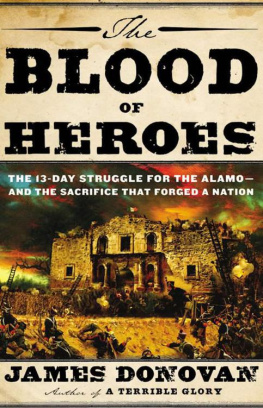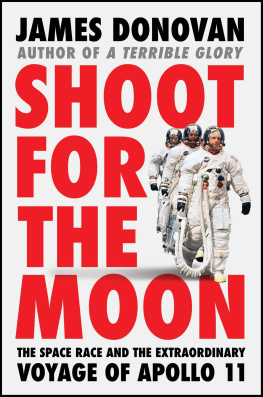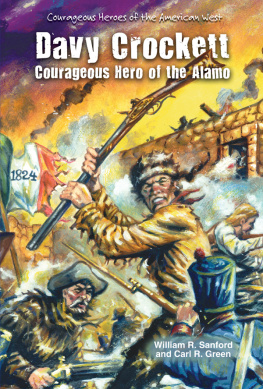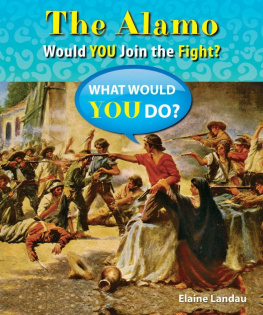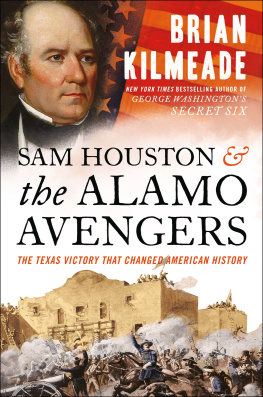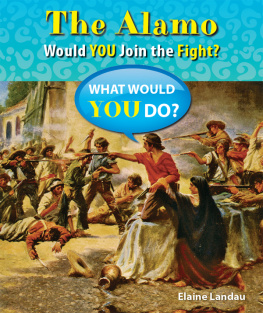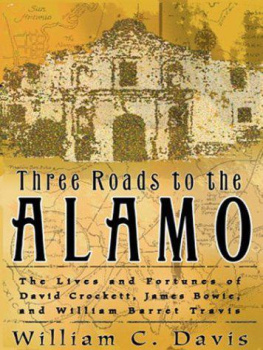

In accordance with the U.S. Copyright Act of 1976, the scanning, uploading, and electronic sharing of any part of this book without the permission of the publisher constitute unlawful piracy and theft of the authors intellectual property. If you would like to use material from the book (other than for review purposes), prior written permission must be obtained by contacting the publisher at permissions@hbgusa.com. Thank you for your support of the authors rights.
T O THE MEMORY OF MY FATHER ,
J AMES M ICHAEL D ONOVAN J R .
H E WAS A GOOD MAN


J ust past nine oclock, sometime after darkness had fallen and before the near-full moon rose, a fleet mare slipped out the south gate of the battered old mission. Riding bareback, using only a bridleevery ounce counted now if he was to outrun General Ramrez y Sesmas lancersthe rider leaped over the moat, spurred his horse to a full gallop, leaned low to hug her neck, and held on for dear life as man and mount thundered through the Plaza de Valero amid scattered musket fire, hoofbeats echoing against the fortress walls. He headed southeast, along the San Antonio River, toward Goliador Fort Defiance, as Colonel James Fannin had dubbed the presidio there.
Fannin and his four hundred men were at least two full days ride away. If the colonel could be persuaded to lead his force to Bxar, it might be four or five days before they arrived. That might be too late. But perhaps they were on the march already.
The Mexican army besieging the fort for the past twelve days outnumbered the small garrison ten to one. Their artillery had bombarded the Alamo almost constantly, though not one Texian or Tejano defender had been killed. But around five that afternoon, the earsplitting barrage had stopped.
James Allens swift horse and his own slight frame had been two important reasons the post commander, Lieutenant Colonel William Barret Travis, had chosen the twenty-one-year-old college student from Missouri to deliver another desperate plea for assistance from the run-down fort.
That Saturday, March 5, 1836, had dawned cool and clearclear enough to reveal that the Mexican lines surrounding the fortress had moved closer again the previous night, the eleventh since the Texian forces had retreated into the compound at the approach of Santa Annas army; an artillery battery now stood just two hundred yards from the north wall. The red flag hoisted above Bxar that first day had made clear the fate of any rebel, Anglo or Mexican, taken alive while fighting for Texas independence: death.
Over the previous twelve days, almost a dozen couriers had made it through the Mexican lines and reached the two closest Texian communities east of BxarGonzales, seventy-five miles away, and Goliad, ninety-five miles downriver, where Fannin and his volunteers held the presidio there. Traviss requests for food, clothing, ammunition, ordnance, and, most important, reinforcements, had gone unanswered, at least as far as the garrison knew, save for thirty-two brave souls sent from the town of Gonzales five days earlier. Other than that, nothingno word from the provisional governor and council in San Felipe, eighty miles beyond Gonzales, or from Fannin only a message two days earlier from Traviss warm friend Major Robert Three-Legged Willie Williamson, stationed in Gonzales, who entreated them to hold out and who promised to send aid soon.
Traviss two-hundred-odd men were exhausted and bedraggled from twelve days of almost constant bombardment and little sleep. They had done all they could to fortify the old mission, but the stone and adobe walls had been erected as protection against Indian attacks, not artillery. Though the enemys largest fieldpiece was only an eight-pounder, the incessant shelling had taken its toll on the walls, particularly the weak northeastern section, which had begun to crumble. Worse, the compound was far too large to be ably manned by so few defenders. With Fannins four hundred, they might have a chance, but an all-out attack seemed imminentprobably even before the rest of Santa Annas army, comprising thousands more men, reached Bxar. As it was, the Mexican entrenchments were moving closer every night.
As the rider disappeared into the darkness, the Mexican troops lay back down to sleep, or tried to. Tomorrow, and its bloodshed, would come soon enough.
He hungered and thirsted for famenot the kind of fame which satisfies the ambition of the duelist and desperado, but the exalted fame which crowns the doer of great deeds in a good cause.
J ONATHAN K UYKENDALL
O n a cold day early in February 1836, a well-dressed young man on a horse trotted along the roadlittle more than a well-worn cart path, reallyfrom the small town of Gonzales westward to San Antonio de Bxar. He was twenty-six, and he had already written his autobiography. He exuded self-assurance, and ambition burned in his breast, but he could be brusque, and perhaps because of that, the men under his command respected him, but did not warm to him. The rebel Texian army had no money for arms and ammunition, much less clothing for its few hundred soldiers, and the uniform he had ordered had not been delivered yet. Thus, despite his newly appointed rank of lieutenant colonel of cavalry in the regular army, he wore the fine clothes of a gentleman.
His civilian dress was no indication of a lack of courage. He had proven his mettle several times in the past few yearsat the port village of Anahuac, staked to the ground with Mexican riflemen aiming at him; then three years later, leading a group of militia to seize the garrison there; and at the siege of Bxar this past fall, in the thick of things with his company of mounted scouts.
His name was William Barret Travis, and he did not want to return to Bxar. A few weeks before, his good friend Henry Smith had been elected governor by the Consultation, the meeting of representatives of most of the Texas settlements that was convened to discuss the increasing friction with Mexico and organize a provisional government to handle matters. The Consultation had been held in the town of San Felipe, the center of the Anglo colonies, where Travis resided. At Traviss own suggestion, Smith appointed him lieutenant colonel and commander of cavalry, then charged him with raising a legion of dragoonsone hundred armed horsemento reinforce the depleted garrison at Bxar. All signs pointed to a large Mexican army on the march to Texas to quash the nascent rebellion in the troublesome colony.
Almost three weeks of recruiting had yielded only thirty-five men, and several of those had deserted the unit on the road. With a legion, a man could make a mark; a third of that number, not so easily. Travis himself had to provision, equip, and sometimes supply mounts for his volunteers, and the job kept him fully occupied. His personal affairs and business concerns suffered, particularly his successful law practice, though the recent acquisition of a partner had helped the latter somewhat. But the unceasing work took its toll. On January 28, soon after leaving San Felipe, dog-tired and disillusioned, Travis had written to Smith from Burnhams Crossing on the Colorado River, just thirty miles west on the Bxar road, and asked to be allowed to return:
Next page
